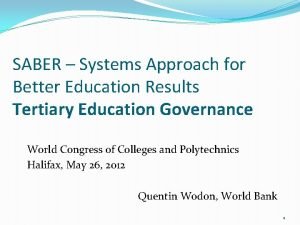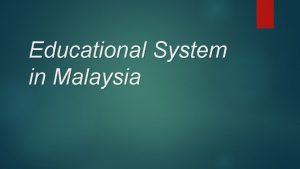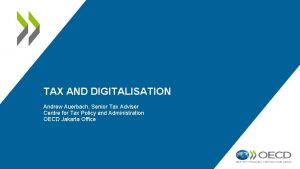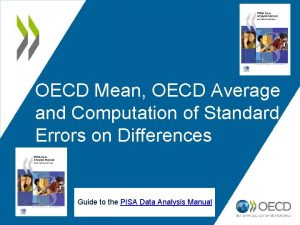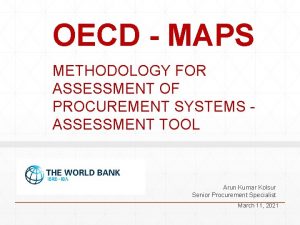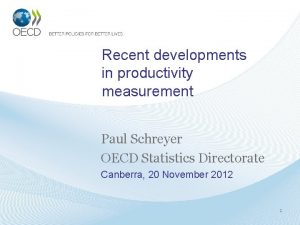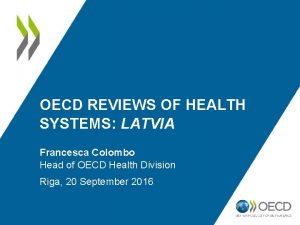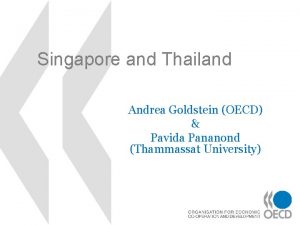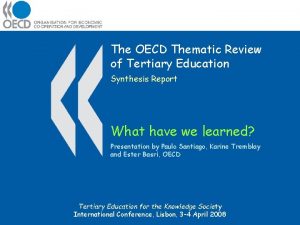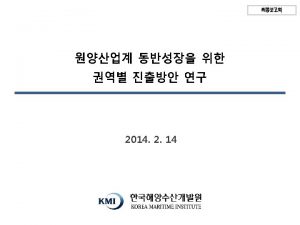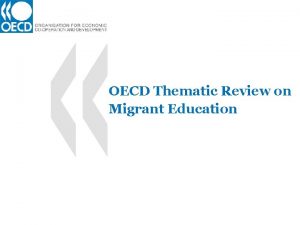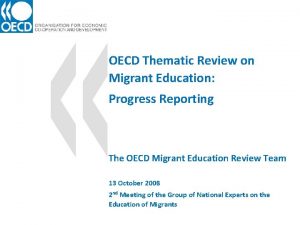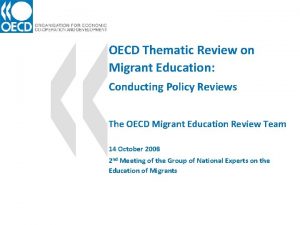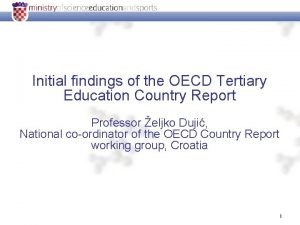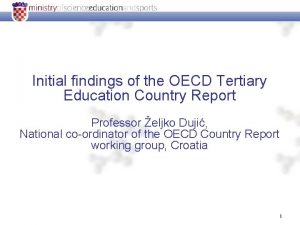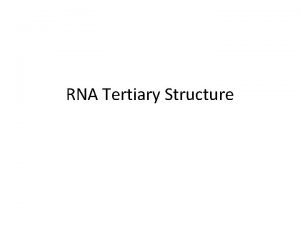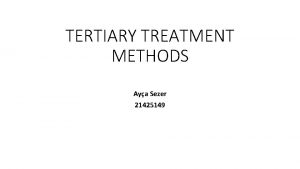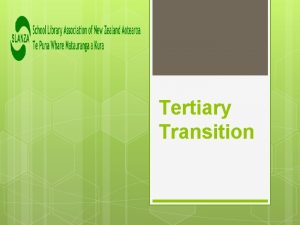OECD Thematic Review of Tertiary Education Comparative Indicators





























- Slides: 29

OECD Thematic Review of Tertiary Education Comparative Indicators on Tertiary Education 1 st Workshop of Participating Countries 6 -7 June, 2005 Hiroyuki Hase OECD Directorate for Education and Training Policy Division

Change in tertiary enrolments, 1995 -2002 OECD country mean for change in tertiary enrolment (140) 2 Source: OECD (2004) Education at a Glance: OECD Indicators 2004.

Tertiary education attainment rate, aged 25 -64, 2002 3 Source: OECD (2004) Education at a Glance: OECD Indicators 2004.

Net entry rates into tertiary education, 2002 % 4 Source: OECD (2004) Education at a Glance: OECD Indicators 2004.

Female as a percentage of new tertiary enrolments, 2002 % 5 Source: OECD Education database, 2004

New tertiary enrolments by age group, Tertiary type A, 2002 % 6 Source: OECD Education database, 2004

Per cent of persons aged 15 and over participating in tertiary programmes, 2001 % 7 Source: OECD Education database, 2003

Tertiary graduates by field of study (Tertiary-type A and advanced research programmes), 2002 8 Source: OECD (2004) Education at a Glance: OECD Indicators 2004.

Distribution of students in tertiary education by type of institutions (Tertiary-type A and Advanced research programmes), 2002 9 Source: OECD (2004) Education at a Glance: OECD Indicators 2004.

Distribution of students, by mode of study (Tertiarytype A and Advanced research programmes), 2002 10 Source: OECD (2004) Education at a Glance: OECD Indicators 2004.

Average duration of tertiary studies (in years), 2002 11 Source: OECD (2004) Education at a Glance: OECD Indicators 2004.

Trends in unemployment advantage (upper secondary + post-secondary non-tertiary) – tertiary unemployment ratio In some countries the unemployment rate advantage of tertiary graduates has declined. 12 In some countries, there has been no marked trend in the unemployment rate advantage of tertiary graduates. Source: OECD (2004) Education at a Glance: OECD Indicators 2004. In some countries the employment rate advantage of tertiary graduates has increased.

Trends in earnings advantage Relative earnings of individuals who attained tertiary education (upper secondary and post-secondary non-tertiary = 100) In 3 countries , earnings advantag e of tertiary graduate s declined. 13 In 5 countries, earnings advantage of tertiary graduates has not changed. In 11 countries the earnings advantage of tertiary graduates has increased despite increased participation. Source: OECD (2004) Education at a Glance: OECD Indicators 2004.

Expenditure on tertiary institutions (% GDP) 14 Source: OECD (2004) Education at a Glance: OECD Indicators 2004.

% Expenditure on tertiary institutions (% total public expenditure), 2001 OECD country mean (2. 8) 15 Source: OECD (2004) Education at a Glance: OECD Indicators 2004.

Change in expenditure per student on tertiary institutions, 1995 -2001 16 Source: OECD (2004) Education at a Glance: OECD Indicators 2004.

Distribution of expenditure on educational institutions, 2001 % 17 Source: OECD (2004) Education at a Glance: OECD Indicators 2004.

Annual expenditure per student on instruction and R&D in tertiary education, 2001 18 Source: OECD (2004) Education at a Glance: OECD Indicators 2004.

Expenditure on tertiary institutions (% GDP) by source 19 Source: OECD (2004) Education at a Glance: OECD Indicators 2004.

Change in expenditure on tertiary institutions (Public expenditure vs. Private expenditure), 1995 -2001 (468) 20 Source: OECD (2004) Education at a Glance: OECD Indicators 2004. (320)

Subsidies for financial aid to students as a percentage of total public expenditure on tertiary education, 2001 21 Source: OECD (2004) Education at a Glance: OECD Indicators 2004.

Foreign students as a percentage of all students, 2002 % OECD country mean (5. 7) 22 Source: OECD (2004) Education at a Glance: OECD Indicators 2004.

Change in foreign students as a percentage of all students, 1998 -2002 23 Source: OECD (2004) Education at a Glance: OECD Indicators 2004.

National students enrolled abroad, 2002 students studying in other countries that report foreign students as % of all tertiary students in each country % (25. 4) OECD country mean (4. 1) 24 Source: OECD (2004) Education at a Glance: OECD Indicators 2004.

% 25 Gross domestic expenditure on R&D as a percentage of GDP Source: OECD (2005) Main Science and Technology Indicators, volume 2004/2.

Gross domestic expenditure on R&D by sector of performance, 2003 % 26 Source: OECD (2005) Main Science and Technology Indicators, volume 2004/2.

Percentage of higher education expenditure on R&D financed by industry 27 Source: OECD (2005) Main Science and Technology Indicators, volume 2004/2.

Total researchers per thousand total employment 28 Source: OECD (2005) Main Science and Technology Indicators, volume 2004/2.

Researchers by sector of employment, 2001 29 Source: OECD (2005) Main Science and Technology Indicators, volume 2004/2.
 Oecd trade facilitation indicators
Oecd trade facilitation indicators Oecd trade
Oecd trade Universal thematic statement examples
Universal thematic statement examples Tertiary education example
Tertiary education example Tertiary education example
Tertiary education example Level of education in malaysia
Level of education in malaysia World bank tertiary education
World bank tertiary education Thematic literature review
Thematic literature review Melinda brown oecd
Melinda brown oecd Oecd trade
Oecd trade Asta auerbach
Asta auerbach Oecd working group on bribery
Oecd working group on bribery Andrew bell oecd
Andrew bell oecd Principles of glp
Principles of glp Oecd nations meaning
Oecd nations meaning Methodology for assessing procurement systems
Methodology for assessing procurement systems Oecd modellegyezmény magyarul
Oecd modellegyezmény magyarul Oecd scenarios for the future of schooling
Oecd scenarios for the future of schooling Paul schreyer oecd
Paul schreyer oecd Oecd well being framework
Oecd well being framework Francesca colombo oecd
Francesca colombo oecd Evaluation cooperation group
Evaluation cooperation group Oecd
Oecd Civil service skills
Civil service skills Pavida pananond
Pavida pananond Oecd space forum
Oecd space forum Oecd guidelines on measuring subjective well-being
Oecd guidelines on measuring subjective well-being Better life initiative
Better life initiative Oecd corporate governance principles
Oecd corporate governance principles Oecd guidelines for corporate governance
Oecd guidelines for corporate governance




